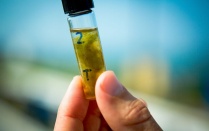UB awarded $2 million to make 'farming' biofuel more efficient and affordable

A byproduct of studying algae in Prof. Bradley's lab.
By Peter Murphy
Published December 12, 2023
Polyculture farming—growing more than one crop species in the same space—mimics natural ecosystems and can increase crop diversity, enhance productivity and help protect against common pests. Engineers at the University at Buffalo are looking to employ similar techniques in biomass harvesting.
Algal cultivation is an effective way to produce biomass, a renewable energy source that can be directly converted into biofuel—a fuel source that would reduce greenhouse gas emissions. The current process takes months and must restart whenever algal is attacked by micro-pests, like fungus. University at Buffalo engineers are developing a method to detect pests before they infect the algal culture and cause major upsets to the system.
The project, funded by a $2 million award from the United States Department of Energy (DOE), will also employ polyculture farming techniques in biomass harvesting.
Algae are micro-organisms that live in aquatic environments. They behave like plants and use photosynthesis to produce energy from sunlight. According to Ian Bradley, principal investigator on the project and assistant professor in the Department of Civil, Structural and Environmental Engineering, harvesting biofuel from algae is effective, but not yet practical.
“The algal cultures are always growing. When the system gets contaminated, the algae get completely wiped out,” says Bradley, who is also a core faculty member in UB's RENEW Institute. “You miss growing biomass for a few weeks or a few months and lose between 30-50% of the product.”
Many biomass harvesters wait until an infiltration from pests occur and add chemicals or use other methods to remedy the infection. Bradley and other researchers will examine environmental conditions like temperature, sunlight, and wastewater treatment, and track changes in the algae’s metagenomes and transcriptomes—DNA and RNA—before and after the organisms are infected. Collaborators at the Georgia Institute of Technology will monitor these organisms using low-cost microscopy and provide updates about algae and pests in real time. The team at Georgia Tech will use artificial intelligence and deep learning to analyze data and try to develop predictive correlations between algae responses and environmental conditions.
“We want to make algae a viable producer for biofuel applications. Right now, it’s expensive and not consistent,” Bradley says. “Our goal is to predict the infections before they occur.”
Viable production
In addition to monitoring and understanding factors that typically lead to infection in algae cultures, Bradley and team will use a different cultivation method to protect biomass production.
“Pure cultures, or monocultures—made up of the same types of algae—are the most common for biomass production. When a fungus comes into a monoculture, it completely wipes it out and you get culture crash,” Bradley says. “We grow polycultures to make the process more sustainable. If fungus attacks and wipes out one type of algae, there are others to continue the process.”
Using polycultures also increases productivity because it prevents a complete restart in the biomass production process. Bradley believes using polycultures instead of monocultures could double productivity.
“We’re in phase one of this project. Phase two is to progress the state of this technology and then scale it up for implementation,” Bradley says.
UB engineers are collaborating with researchers from Georgia Tech and Clearas Water Recovery, Inc., along with the University of Illinois Urbana-Champaign, on the project supported by the DOE’s Bioenergy Technologies Office (BETO). BETO awarded over $18 million in funding to several projects to produce affordable biofuels and bioproducts that reduce greenhouse gas emissions.
“The projects will create good-paying jobs, support rural economies and encourage participation of underserved communities, all while putting the United States on a path to a clean and equitable energy economy,” the DOE says.









